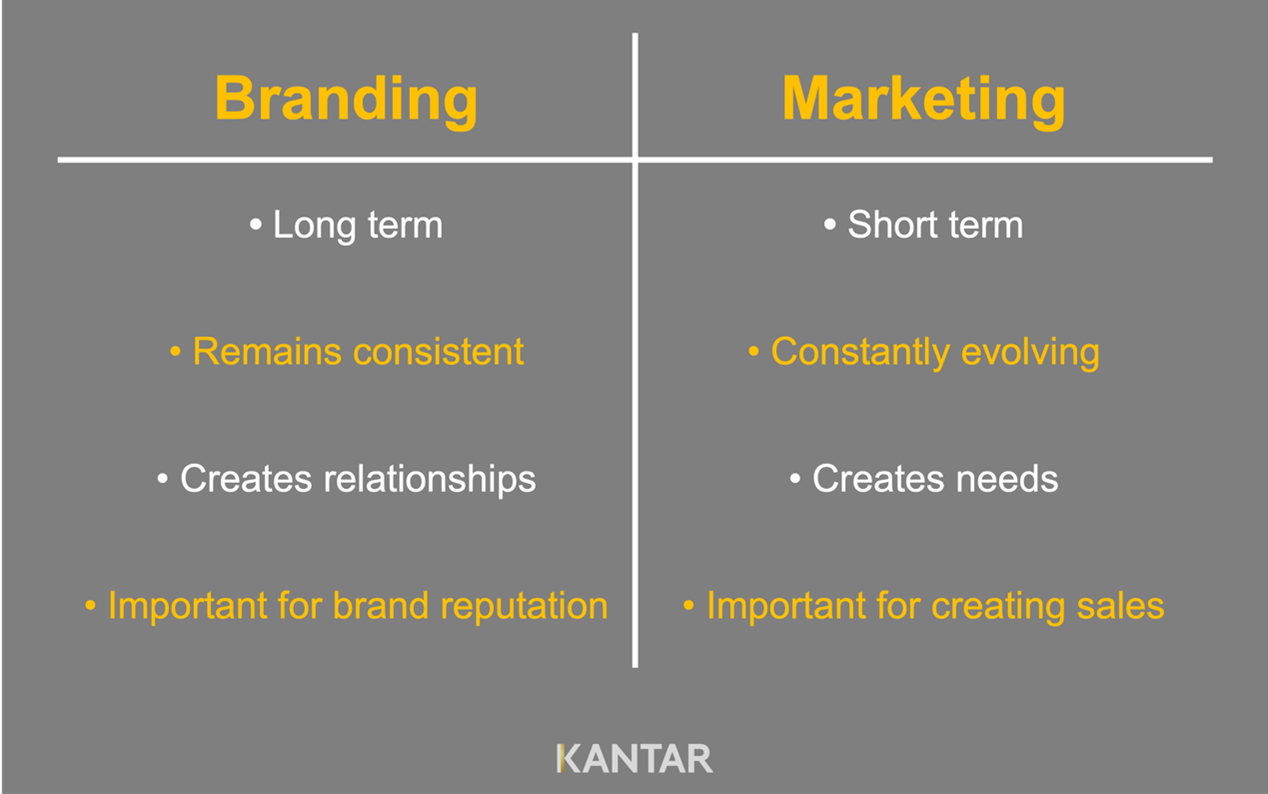Branding and marketing are two of the most essential aspects of creating and managing a successful business. Yet, despite their importance, the two terms are often used interchangeably.
When it comes to branding vs marketing, what’s the difference and why does it matter?
Branding vs marketing: Definitions
What is branding?
It’s often hard to pin-point what branding is, as it’s associated with an idea or a perception, rather than a concrete ‘thing’, however, it is one of the most important aspects of business.
In the most literal sense, branding is the activity of connecting a product with a particular name, symbol, etc. or with particular features or ideas, in order to make people recognize it and want to buy it . Essentially – it is the thing that makes people recognize your brand, what makes it distinctive on the shelf and stand out from the crowd.
Type of branding include:
- Corporate branding: Corporate identity is one of the most important and common identity is one of the most important and common types of branding. It is all about how a brand is perceived. If a company is seen in a positive light, people will be willing to pay more.
- Product branding: Product branding refers to the branding of a specific product, rather than the whole company behind the product.
- Service branding: Service branding is all about the customer service you are providing. Great customer service helps build your brand reputation.
- Personal branding: Personal branding is linked to public figures including athletes, politicians, actors, singers, and social media influencers.
What is marketing?
Marketing is the business activity that involves finding out what customers want, using that information to design products and services, and selling them effectively.
Types of marketing include:
- Digital marketing: Digital marketing is an all-encompassing term for many popular types of marketing via digital (online) channels, such as pay-per-click and social media marketing.
- Email marketing: Email marketing is the process of sending emails to old and new customers in the hopes of pushing them to the point of purchase.
- Content marketing: Content marketing is often seen as part of digital marketing where businesses create online content in which to showcase their products.
- Social media marketing: Social media marketing is often seen as a form of content marketing (as well as a form of digital marketing) as it involves the creation of content for distribution across social media. This is a valuable strategy whereby brands promote themselves on platforms such as Facebook, YouTube, Instagram, TikTok, and Pinterest. It has been proven to be a key strategy when looking to lift brand awareness.
- Influencer marketing: Closely linked with social media marketing is the concept of influencer marketing which involves using online or social media celebrities to help endorse and advertise brands and products. This is a rapidly growing form of marketing, more than doubling since 2019 and valued at $13.8bn USD in 2021.
So, both branding and marketing look to influence a consumer’s decision to purchase a product. But what’s the difference between the two?
What’s the difference between branding and marketing?
Branding and marketing are both essential to making a business successful and both look to convince a consumer that the product being sold is the best out there.

- Long term vs short term
Branding is all about the long-term goals and identity of a company. It represents a business’ values, ideals, and ambitions. Meanwhile, marketing is a short-term solution that isn’t rooted in one particular message. - Consistent vs fluid
Linked with the above is the question of consistency vs fluidity. Branding is the over-arching way you appear to the world. It is consistent and unchanging while marketing constantly evolves to match market trends and themes. - Relationship vs needs
Branding is all about creating a relationship with the consumer. It creates a long-term image of the brand that sticks in consumes’ minds and builds up an emotional connection. In contrast, marketing looks to create a need – convincing a consumer to buy the product because they need it now. - Reputation vs sales
The main thing the above three points come down to is the idea of creating a reputation vs creating sales. Branding is an identity that comes to be associated with your business, the stronger the identity and differentiation, the more consumers are willing to pay; marketing is a tool with which to drive sales.
What is more important, branding or marketing?
So now we have clarified what is branding vs what is marketing, we need to consider what comes first: branding or marketing?
While neither is more important – both should work hand-in-hand – branding should always come first. Branding helps to define marketing, delivering the brand cues that are vital for brand equity. Indeed, there’s no point in having a good marketing campaign with no branding – if consumers don’t recognize or remember which brand was behind a marketing campaign, then you’ve wasted money.
Branding examples
When it comes to figuring out how to create a successful brand strategy, brand cues are key. Let’s take a look at some branding examples to see how businesses have successfully employed distinctive assets.
Memorable logos
The golden arches are a prime example of strong, distinctive branding that has remained consistent. Without us needing to say anything else, you already know that we are referring to McDonald's. What about the iconic Nike swoosh, a staple of the brand since 1971 (alongside a rename from Blue Ribbon Sport).

Source: The Logo Creative
Distinctive colors
As we explored in the section on the difference between branding and marketing, branding is an identity, a long-standing, consistent image of your brand that consumers come to recognize. While logos are one way to do this, brands also employ distinct color schemes to create immediate associations in the minds of consumers. Look at the branding examples below and see if you can identify the brands from their distinctive use of color (answers at the bottom).

Answers to brand color quiz:
1 – Subway, 2 – Tiffany’s, 3 – Google, 4 – Ikea
Putting effort into creating a distinctive brand is well-intentioned, but if you can’t track the results, then how do you know if you’ve been successful? Having a system in place to track and optimize your brand performance, and monitor your brand versus competitors, will help ensure that your efforts aren’t wasted.
Get in touch to see how the Brand Team at Kantar can help you refine and track your branding and grow your brand.


